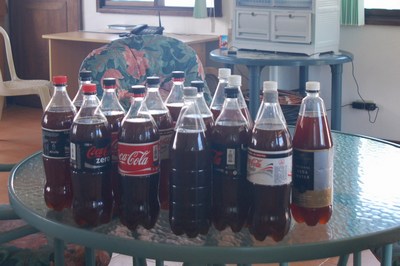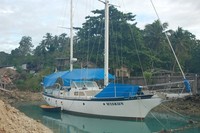
SAIL SAMAL, PHILIPPINES
Come join us in this wonderful island in the Southern Philippines
20 June 2009 | Davao and Samal, Philippines
01 May 2009 | Samal and Davao, Philippines
25 February 2009 | Samal Island
02 February 2009 | Davao, Philippines
23 January 2009 | Davao, Philippines
11 January 2009 | Davao, Philippines
07 January 2009 | Davao, Philippines
24 December 2008 | Davao Gulf, Philippines
21 December 2008 | Davao Gulf, Philippines
19 December 2008 | Davao
17 December 2008 | Philippines
16 December 2008 | Pacific
15 December 2008 | Pacific
13 December 2008 | Pacific
12 December 2008 | Pacific
10 December 2008 | Samal, Davao Gulf
06 December 2008 | South Pacific
05 December 2008 | South Pacific
04 December 2008 | South Pacific
02 December 2008 | South Pacific
Brew Your Own Beer
11 January 2009 | Davao, Philippines
wiskun

We brew our own beer. In sailing, we do a lot of entertaining and it is always nice to share a cold mug of beer with our guests, especially in the tropics. In most countries, the cost of buying beer is horrendous. So, in New Zealand, we were able to learn the art of brewing beer from our German friends. I was surprised that it is really very easy. All you need is a 25 liter jug, preferably with a spout and a vent, lots of plastic bottles with sealable caps, a weighing scale and a syringe. When it comes to bottles, I used old pop bottles, and I prefer the coke or pepsi brand because the quality of their bottles are very good. I use the sterilizing powder to clean it, but our German friends who have done this for years only use hot water. They said it is good enough.
The brewing kit that you buy determines the process, of course, and the one I am going to describe here is for the Coopers, Australian brand. The kit contains a hopped malt concentrate and a sachet of yeast. The only other ingredients you will need are sugar and water. I have tried white, brown and cane sugar. For water, it is best to use rain water, unbleached. Ready?
1- Fill the 25 liter jug halfway with water
2 - Pour water into 2 big pots, halfway, and start to heat. Do not boil, you only need the water warm enough to melt the sugar and the malt concentrate
3 - Measure 800 grams to 1 kg. of sugar. The more the sugar, the higher the alcohol content
4 - When the water is warm enough, pour the sugar into the pots, half to each. Stir constantly.
5 - Do the same for the malt concentrate.
6 - It is wise to pour hot water into the can to melt the leftover concentrate faster. The concentrate is very sticky.
7 - Once the mixture is ready, you can pour all of them into the 25 liter jug (including from the can). Top up until you reach 23 liters. Do not fill to the top as you need room for the fermentation process.
8 - Pour the yeast that came with the kit into the jug and stir. Make sure the mixture is not too hot or it will kill the yeast. About 20 degree celsius is ok.
9 - Tighten the lid on the jug, as tight as you can.
The fermentation process will start immediately, and within 24 hours, you will see or hear the bubbling. Between 21-26 degrees celsius, this process should take 5-6 days. I normally just watch the bubbling. When it stops, then I know it is ready. I don't go beyond 7 days though. I was told the mixture will start to turn sour if you wait too long. Meanwhile, prepare for the second fermentation process. Sterilize all the bottles.
The second fermentation requires sugar in the bottles with the beer mix. This is the process that will create the fizz. My German friends gave me this formula to make it easier: Combine 375 ml of warm water and 250 grams of sugar. Stir until all the sugar has melted. With the syringe, transfer the sugar mix into the bottles, as follows:
600 ml bottle = 12 ml sugar mix
750 ml bottle = 15 ml sugar mix
1 liter bottle = 20 ml sugar mix
1.25 liter bottle = 25 ml sugar mix
1.50 liter bottle = 30 ml sugar mix
Pour the beer mix into the bottles but leave room on top for the fermentation process. Securely tighten the caps and shake a little for the sugar to mix in. The beer will be ready to drink in one month's time, but this never happens with us. Within 2 weeks, Kjartan is already drinking it and he said it is very good. One will note some leftover white substance at the bottom of the bottles. This is yeast (full of vitamin B), and is not harmful to you. I don't bother to eliminate them. We just make sure we don't shake the bottle too much when pouring into the mug.
I've been making beer for the last 4 years. Coopers has lager, draught, pale ale, dark ale and all the way to the darkest beer, the stout. I can't remember the price of the Kiwi beer, but I think it runs around NZ$2.00 for a 750 ml. bottle. With the beer kit, I can produce 23 liters of beer at a cost of less than NZ$0.50 per 750 ml bottle. Of course, this doesn't make sense here in the Philippines as the price of the San Miguel beer is very cheap. But, once in a while, Kjartan prefers the Coopers, and I will continue to make them until I run out of beer kits.
As a side note, I don't drink beer. I was told that when you are a beer drinker, the mosquitoes don't like your blood. One possible reason is the Vitamin B1 in the yeast. One of our cruising friends take Vitamin B1 (not the B-complex, but straight just B1). She said this prevents mosquitoes from attacking her. Could this be true? I don't know. All I know is that I don't drink beer and mosquitoes love me. They don't attack Kjartan at all.
The brewing kit that you buy determines the process, of course, and the one I am going to describe here is for the Coopers, Australian brand. The kit contains a hopped malt concentrate and a sachet of yeast. The only other ingredients you will need are sugar and water. I have tried white, brown and cane sugar. For water, it is best to use rain water, unbleached. Ready?
1- Fill the 25 liter jug halfway with water
2 - Pour water into 2 big pots, halfway, and start to heat. Do not boil, you only need the water warm enough to melt the sugar and the malt concentrate
3 - Measure 800 grams to 1 kg. of sugar. The more the sugar, the higher the alcohol content
4 - When the water is warm enough, pour the sugar into the pots, half to each. Stir constantly.
5 - Do the same for the malt concentrate.
6 - It is wise to pour hot water into the can to melt the leftover concentrate faster. The concentrate is very sticky.
7 - Once the mixture is ready, you can pour all of them into the 25 liter jug (including from the can). Top up until you reach 23 liters. Do not fill to the top as you need room for the fermentation process.
8 - Pour the yeast that came with the kit into the jug and stir. Make sure the mixture is not too hot or it will kill the yeast. About 20 degree celsius is ok.
9 - Tighten the lid on the jug, as tight as you can.
The fermentation process will start immediately, and within 24 hours, you will see or hear the bubbling. Between 21-26 degrees celsius, this process should take 5-6 days. I normally just watch the bubbling. When it stops, then I know it is ready. I don't go beyond 7 days though. I was told the mixture will start to turn sour if you wait too long. Meanwhile, prepare for the second fermentation process. Sterilize all the bottles.
The second fermentation requires sugar in the bottles with the beer mix. This is the process that will create the fizz. My German friends gave me this formula to make it easier: Combine 375 ml of warm water and 250 grams of sugar. Stir until all the sugar has melted. With the syringe, transfer the sugar mix into the bottles, as follows:
750 ml bottle = 15 ml sugar mix
1 liter bottle = 20 ml sugar mix
1.25 liter bottle = 25 ml sugar mix
1.50 liter bottle = 30 ml sugar mix
Pour the beer mix into the bottles but leave room on top for the fermentation process. Securely tighten the caps and shake a little for the sugar to mix in. The beer will be ready to drink in one month's time, but this never happens with us. Within 2 weeks, Kjartan is already drinking it and he said it is very good. One will note some leftover white substance at the bottom of the bottles. This is yeast (full of vitamin B), and is not harmful to you. I don't bother to eliminate them. We just make sure we don't shake the bottle too much when pouring into the mug.
I've been making beer for the last 4 years. Coopers has lager, draught, pale ale, dark ale and all the way to the darkest beer, the stout. I can't remember the price of the Kiwi beer, but I think it runs around NZ$2.00 for a 750 ml. bottle. With the beer kit, I can produce 23 liters of beer at a cost of less than NZ$0.50 per 750 ml bottle. Of course, this doesn't make sense here in the Philippines as the price of the San Miguel beer is very cheap. But, once in a while, Kjartan prefers the Coopers, and I will continue to make them until I run out of beer kits.
As a side note, I don't drink beer. I was told that when you are a beer drinker, the mosquitoes don't like your blood. One possible reason is the Vitamin B1 in the yeast. One of our cruising friends take Vitamin B1 (not the B-complex, but straight just B1). She said this prevents mosquitoes from attacking her. Could this be true? I don't know. All I know is that I don't drink beer and mosquitoes love me. They don't attack Kjartan at all.
Comments
| Vessel Name: | Wiskun |
| Vessel Make/Model: | Samson C-Breeze |
| Hailing Port: | Vancouver, BC , Canada |
| Crew: | Kjartan Sekkingstad and Ellen Lee-kwen |
| About: | We sailed out of Vancouver, BC in 2002 and are now in a beautiful island in the Gulf of Davao, Southern Philippines. |
| Home Page: | http://www.sailsamal.com/ |
Gallery not available
WISKUN

Who: Kjartan Sekkingstad and Ellen Lee-kwen
Port: Vancouver, BC , Canada